MB&F LM Sequential EVO Dual Chronograph: An Ingenious Application Of A Simple Idea (That Nobody Had Thought Of Before)
by Ian Skellern
I had a chance to handle the MB&F LM Sequential EVO “Twinverter” fully integrated dual chronograph (with a twist) during Watches & Wonders 2022, with MB&F founder and CEO Max Büsser explaining that it was basically a double chronograph, how it worked, and what you can do with it – and I’m thinking, interesting but not revolutionary.
Büsser then went on to explain what the “Twinverter” did and how it worked in allowing multiple timing modes – and now I’m thinking, it’s revolutionary, but what use is it?
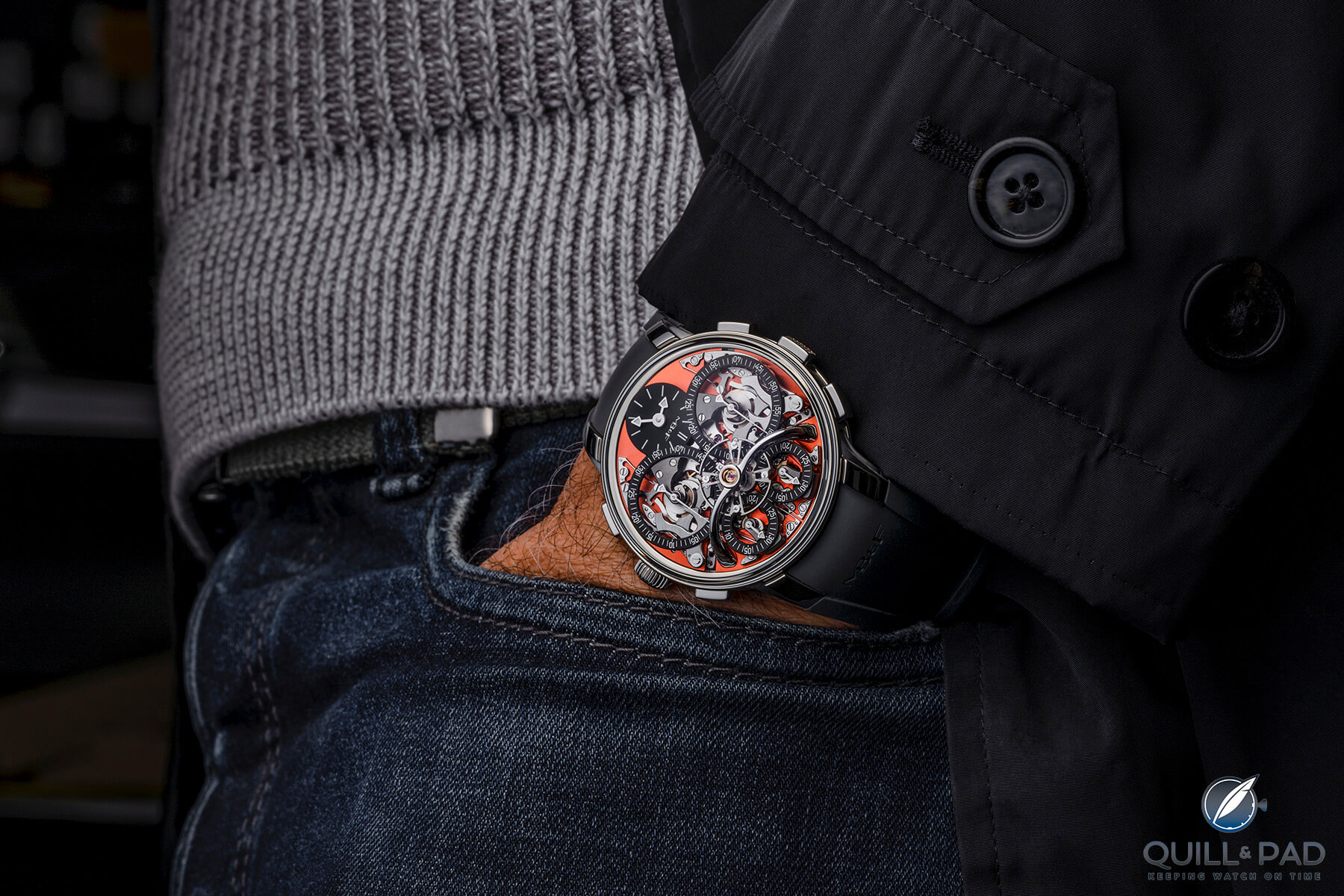
MB&F LM Sequential EVO with orange dial on the wrist
And then Büsser explained quite a few – many more than I imagined – events that you could/ time with the Twinverter – and now I was thinking that the LM Sequential EVO double chronograph was the most exciting chronograph I’d seen since the A. Lange & Söhne Datograph: not so much for what the Sequential EVO does, but because it does something no chronograph has done before.
The horological genius behind LM Sequential EVO is (once again) Belfast-based Stephen McDonnell, who also designed the movement of the (also revolutionary) MB&F LM Perpetual, which launched in 2015. In a recent old school call with McDonnell to discuss the movement, he explained that he couldn’t do Zoom because didn’t have a smart phone, they hadn’t yet been invented where he lives, in the 19 century.
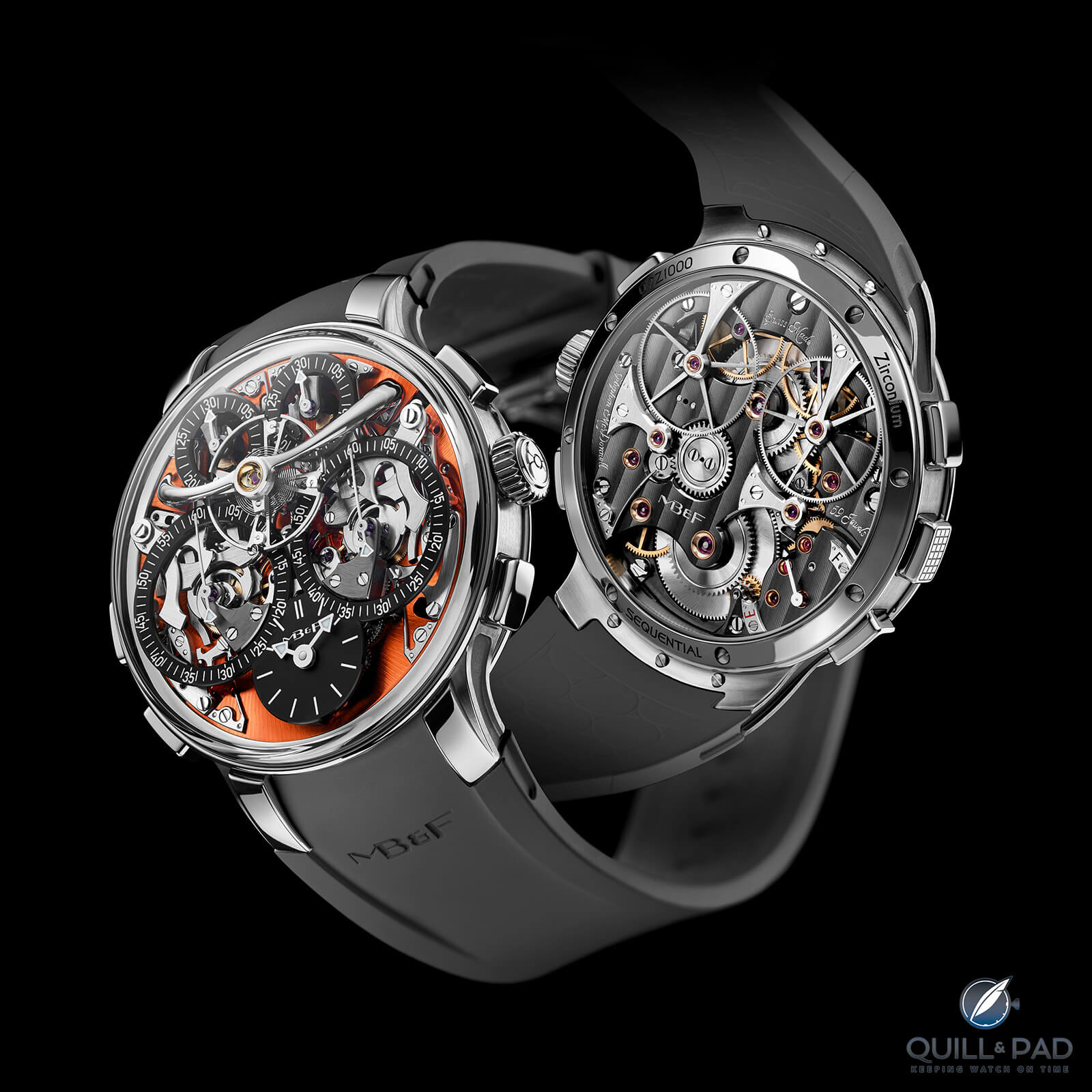
MB&F LM Sequential EVO with orange dial
MB&F LM Sequential EVO: movement
I’d normally begin this first section with a tour of the watch dial, features, and how it works, but the LM Sequential EVO is a monument to its mirror-image double chronograph with Twinverter. Virtually everything else – no, make that everything else – plays second fiddle to the movement (or movements) within.
While there are two chronographs in this in-house, integrated movement (no module on top of a base movement), they both share a single, double mainspring and escapement (with a high, aerobatic, central flying balance wheel), so I think that it’s safe to say that we can (and should) call it a single movement.
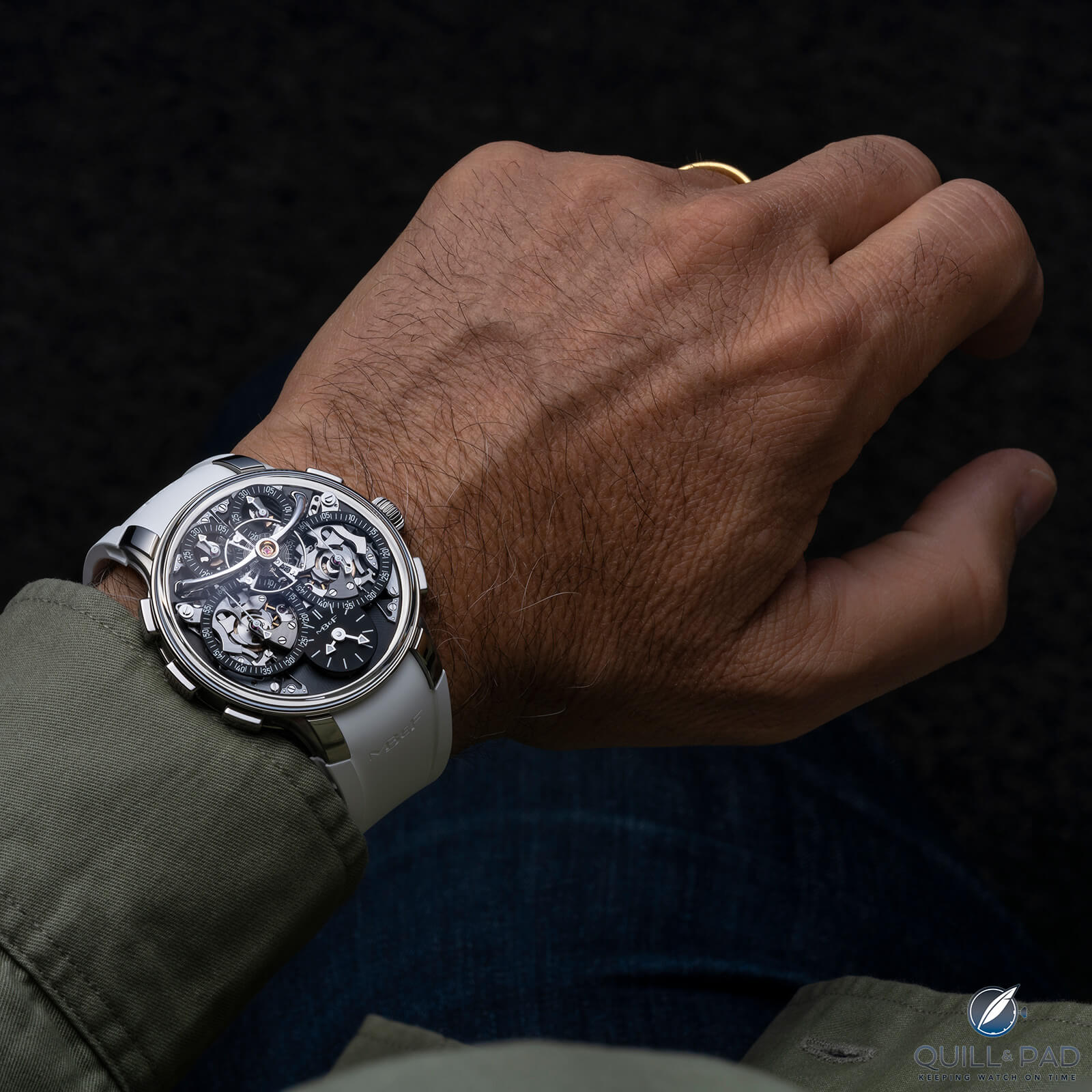
MB&F LM Sequential EVO with black dial on the wrist
Taking a step back, it’s worth a refresher on just how difficult it is to design and construct a new chronograph movement. A tourbillon is often described as a difficult movement for a watchmaker to assemble as the mechanism requires higher finesse than assembling and regulating simpler movements.
But a good fully integrated chronograph movement is one of the most challenging complications to design as it has so many components and mechanisms that have to precisely connect with each other in three – make that four – dimensions.
When Büsser asked McDonnell if he would be interested in working on a new complication, McDonnell replied that he thought that current chronographs had many limitations and that he had a few ideas to solve those.
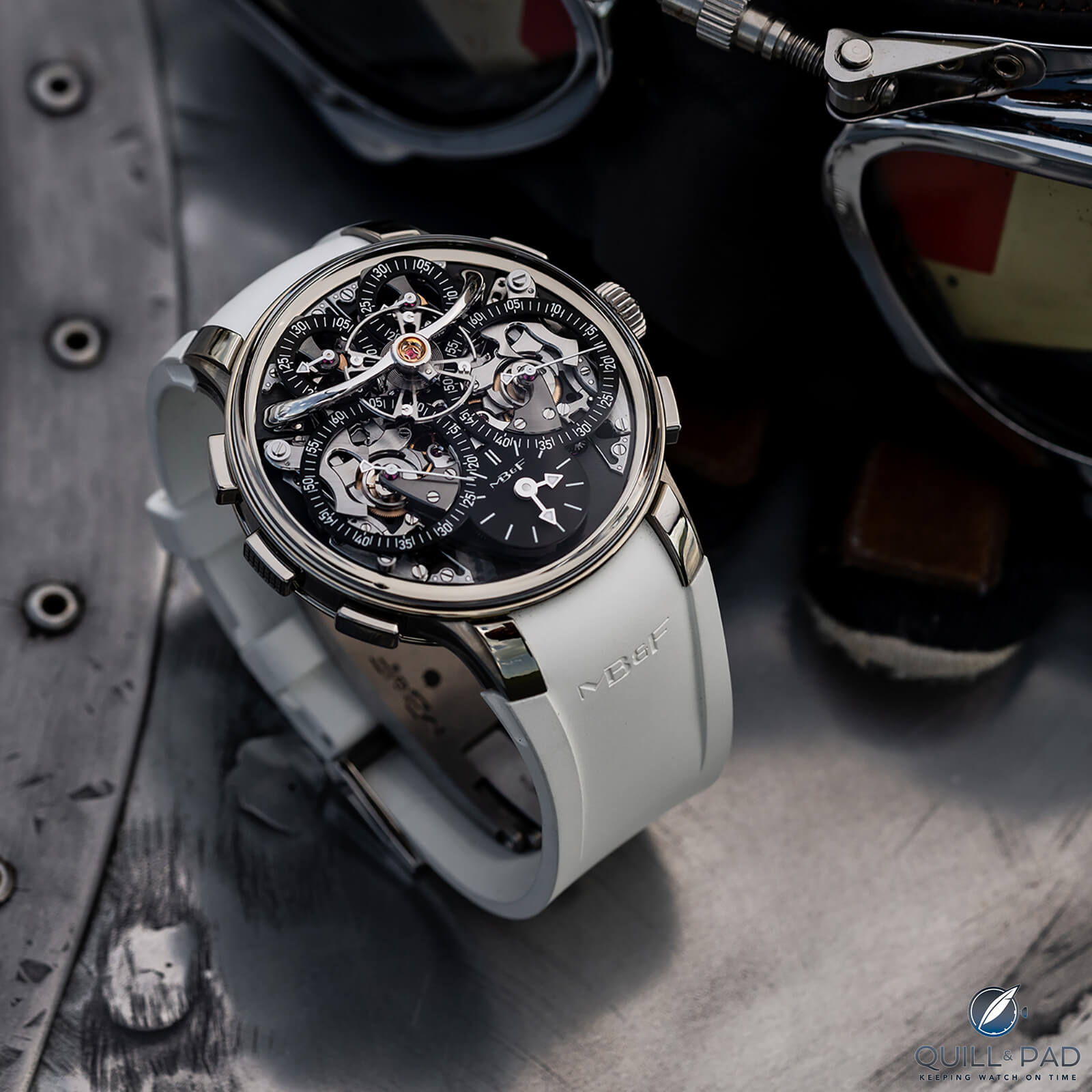
MB&F LM Sequential EVO with black dial
The inspiration for the LM Sequential came from McDonnell’s desire for a chronograph that could measure sporting lap times. In the good old days, racing car laps were timed using multiple monopusher stopwatches mounted on. a panel, with with a lever or bar over the top of them all.
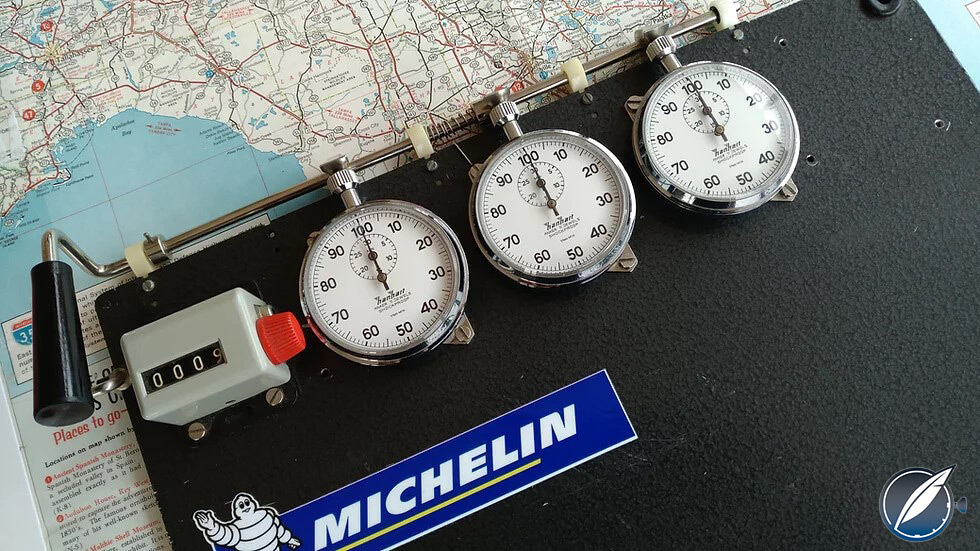
Old school mechanical stopwatch laptimers
Pushing the lever down starts or stops all of the chronographs simultaneously: if one chronograph was running and the other stopped, the lever pushed both buttons down, reversing their functions.
The Twinverter is basically that stopwatch lever.
But the problem with timing events using multiple stopwatches, or even two separate chronograph movements, is that each has its own escapement and regulator, and these are likely to all be running at slightly different speeds. Having two chronograph mechanisms sharing a single regulator solves this issue.
The Sequential EVO chronograph can record two separate events simultaneously, e.g., two competitors in a race, which is nothing more complicated than developing a brand-new compact chronograph movement and another that’s its mirror image (with the reversed movement’s chrono hands still rotating in the correct direction).
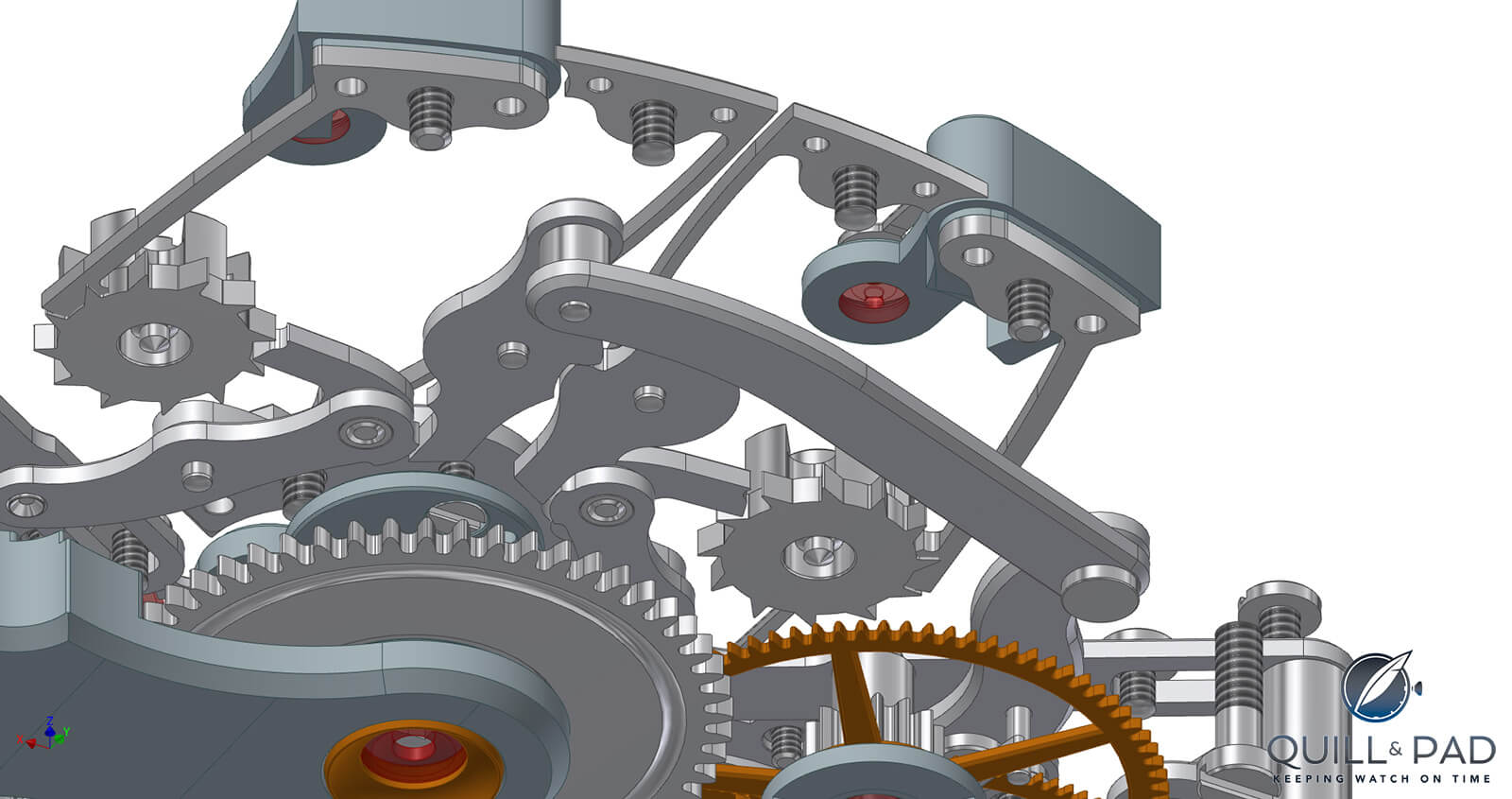
MB&F Twinverter mechanism for the LM Sequential EVO
These two chronographs are linked by the Twinverter mechanism. At the push of a button on the caseband at 3 o’clock, the Twinverter can either start both chronographs (switching them both on or off together), or invert them (switching the one running off and the other not running one on).
The Twinverter works by switching the on-off state of each chronograph’s column wheel. It’s activated by a pusher at 9 o’clock on the case band.
But the Twinverter isn’t the only innovation in the Sequential EVO. Conventional chronographs all have one big flaw: they waste a lot of energy, which is a precious resource in a tiny watch movement. When the chronograph isn’t being used, the gear train for the elapsed seconds and minutes hands is not under any tension, so the hands can flutter slightly. To overcome this, a small tension spring is added to both the elapsed seconds and minutes.
This means when the chronograph starts, the power first has to overcome these tension springs, and this can drop the balance wheel amplitude by 20-30 degrees. That’s 20-30 degrees while the chronograph second hand is running and another 20-30 degrees when the chronograph minute hand jumps.
And that balance amplitude drop would double with two chronographs running simultaneously.
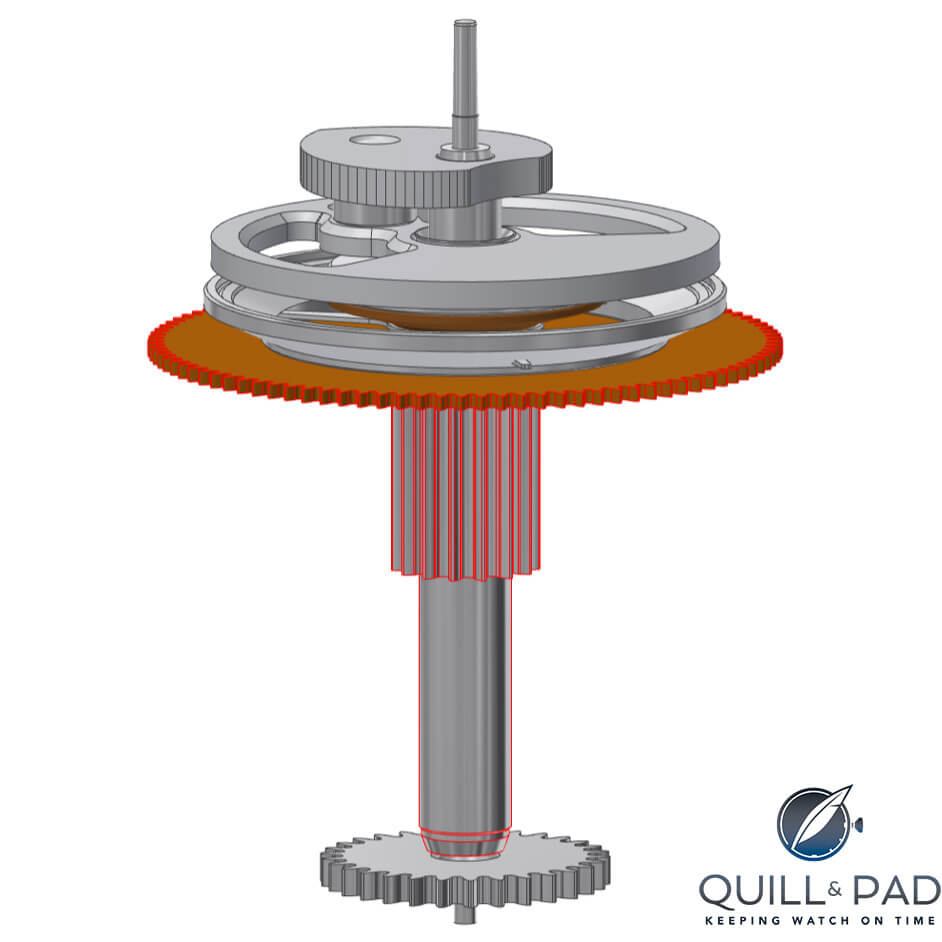
MB&F LM Sequential EVO coaxial clutch
The patented coaxial chronograph clutches of the Sequential EVO solve this waste of energy by being integrated into each of the two chronograph’s gear trains. There’s no amplitude drop when the chronograph is in operation. These clutches are as big an innovation as the Twinverter.
The secret to the Twinverter is its two coaxial clutches that activate and deactivate each chronograph. And the secret to the coaxial clutches is their jeweling. Vertical clutches are not usually jeweled and as oils degrade, they can seize and require replacing rather than repair. The abundant jewels in the clutches ensure that friction is low, the balance amplitude does not change where one or both chronographs are running or not, and the clutch can be dismantled and serviced if necessary rather than require replacement.
And there’s another innovation: well-separated elapsed time second and minute indications. Most chronograph minute hands jump every minute due to a finger on the seconds wheel passing every 60-seconds. This means that the chrono minutes have to be close – and usually within – the chrono seconds indicator mechanism.
On the Sequential, a large intermediate wheel (one for each chronograph) replaces that finger, allowing the chrono second and minute indications to be well separated and easier to read.
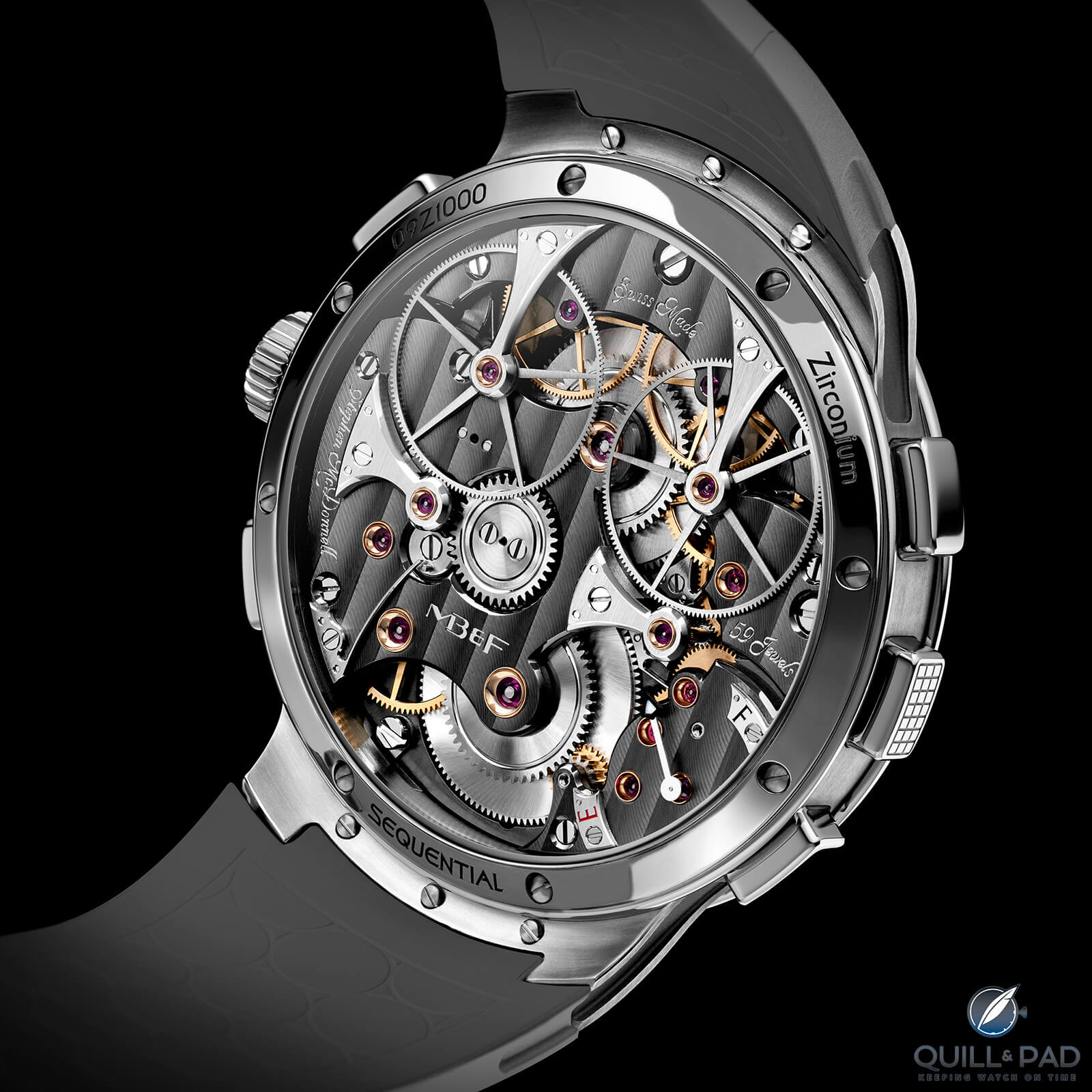
Back of the MB&F LM Sequential EVO
The two large mainspring barrels dominate the movement below the dial. Each powers one of the two chronograph movements’ going trains. Each mainspring barrel powers an individual train of wheels, and each of these trains contains one vertical clutch (replacing the seconds 4th wheel of a conventional geartrain. The two chronograph gear trains then converge on the escape wheel pinion and together drive the single escapement and oscillator. This layout enables all of the wheels of each chronograph gear train, including the clutches, to be always under tension, and so eliminating any need for energy-sapping friction springs.
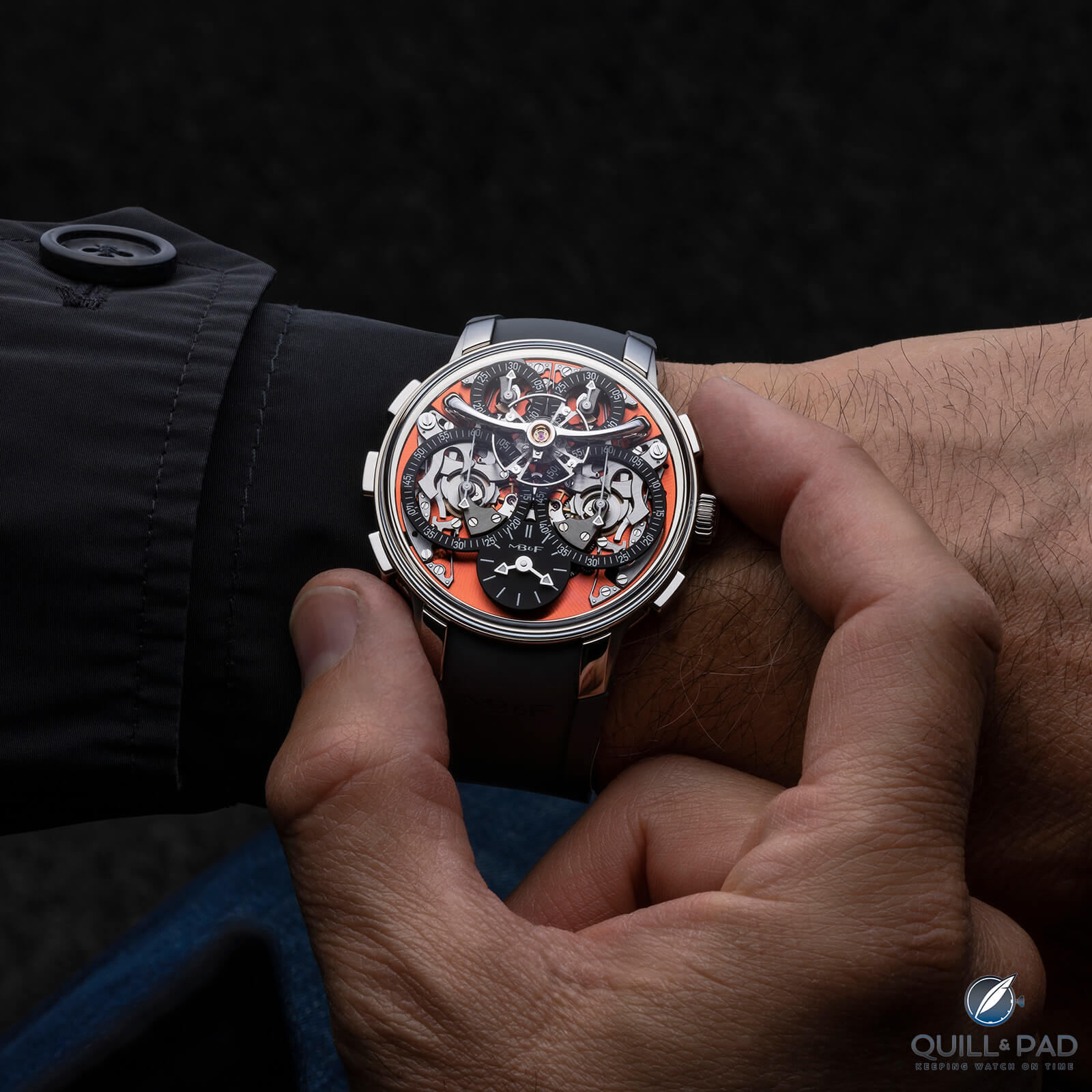
MB&F LM Sequential EVO
The MB&F LM Sequential EVO has five patents covering:
- The overall concept of the actual functionality of the watch
- The technical aspects of the Twinverter, and how it advances the 2 column wheels simultaneously
- The internal jewelling of the vertical clutches
- The use of double braking levers acting on a special braking disc for each clutch, which means that the seconds counter hand can’t flutter while the chronograph is stopped (eliminating the need for tension springs)
- The way in which the minute counters are laid out (axes far from those of seconds counters has not been done before) and driven by means of constant-mesh transmission large diameter intermediate wheels.
Four modes of use of the MB&F LM Sequential EVO
As well as operating as a standard chronograph, there are four other modes available with the LM Sequential EVO.
1. Independent mode – timing two different events, e.g., two competitors in a race with different starting and finishing times. Here the Sequential EVO works like having two stopwatches.
2. Simultaneous mode – timing two events that start simultaneously but with two different finishing times.
3. Cumulative mode – timing the cumulative durations of two discontinuous events.
4. Sequential mode or lap-timer – timing the sub-duration of a single continuous event.
This can be, for example, used to time a competitive chess match where each player has a limited total time to move pieces; for most major events players have 90 minutes for the first 40 moves followed by 30 minutes for the rest of the game, with an addition of 30 seconds per move starting from move one. By starting one of the Sequential EVO’s chronographs when the first player starts playing, simply pushing the Twinverter button simultaneously stops both the first player’s chronograph and starts the competitor’s chronograph. Pushing again does the same thing in reverse.
When cooking you can time two things underway at once.
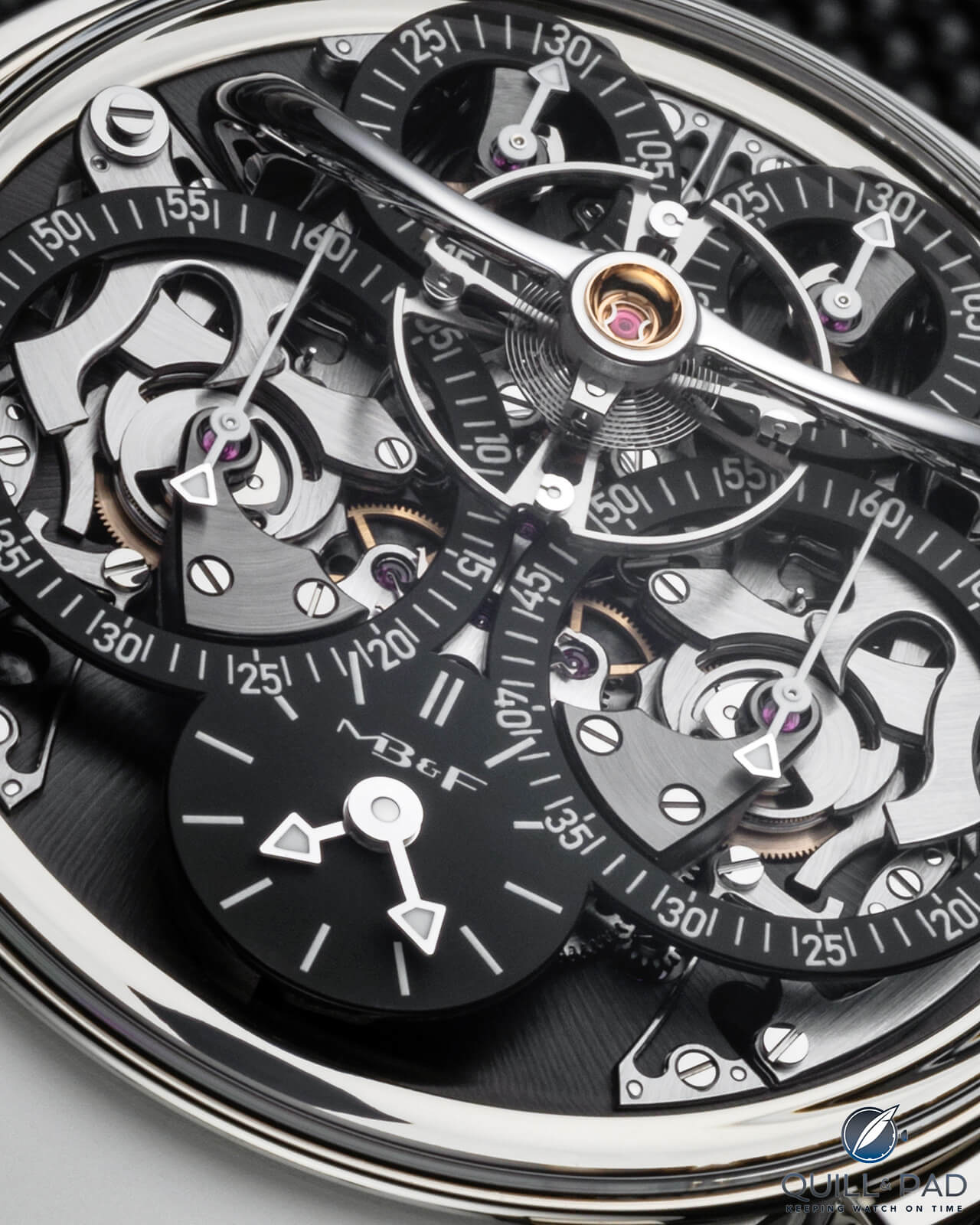
MB&F LM Sequential EVO dial closeup
The first thing you notice when focusing on the dial is that it looks complicated, with circles of indications, chrono counters, and the floating balance filling multiple dimensions: the visible mechanical complexity/artistry goes all the way down. The sheer amount of information seems overwhelming.
Then standing back a bit, you see just how big the dial is: it completely fills the large 44 mm diameter case. And speaking of that case and highly domed sapphire crystal, it is 18.2 millimeters in total height yet looks practically slim. That’s incredible in a case housing a movement with 585 components and seven indications. Larger diameter cases are not so much of a problem on smaller wrists if the watch is relatively flat (slim), it’s the bulky, thick watches that tend to try and wrap around smaller wrists.

MB&F founder and CEO Max Büsser wearing a MB&F LM Sequential EVO
The height of the case is largely due to the highly domed crystal, which adds half of the height, the actual case accounting for only about half of the total thickness.
But back to that dial. It’s easiest to orient yourself to the dial by ignoring (it’s not easy) that high-flying balance wheel arcing over the dial at the center top and focusing instead on the hours-and-minutes subdial at 6 o’clock. That’s telling you the time.
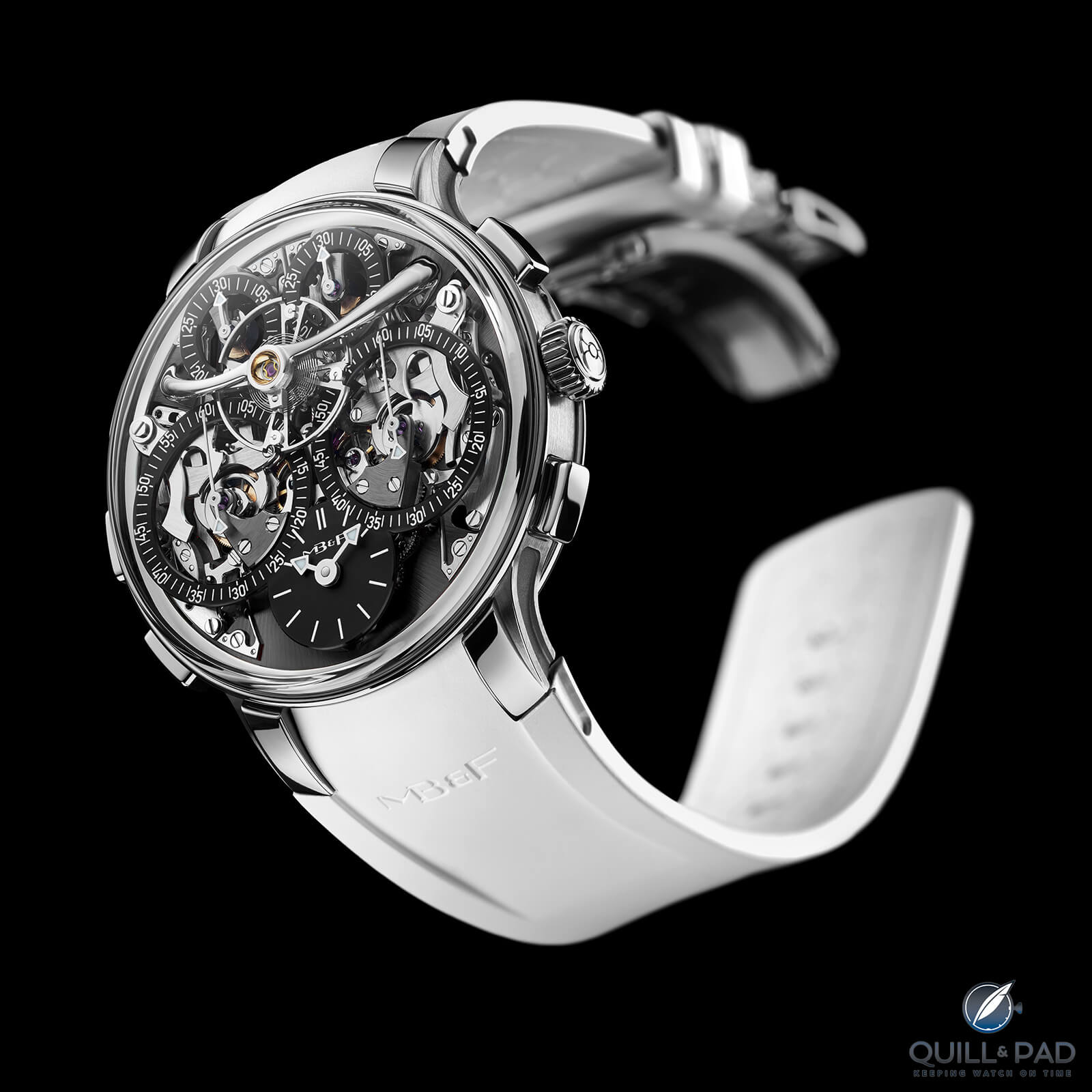
MB&F LM Sequential EVO
Above – at 9 o’clock and 3 o’clock – are mirror-image, large-diameter “dials,” empty but for their orbiting chapter rings indicating each of the two chronographs’ counters for seconds.
Above again – at 11 o’clock and 1 o’clock – are mirror-image, smaller diameter “dials,” again empty but for their orbiting chapter rings indicating each of the two chronographs’ 30-minute counters.
LM Sequential EVO is no discreet wallflower, it looks like a grand complication that you’re not quite sure what it does.
MB&F LM Sequential EVO: case
As with the MB&F LM Perpetual, the Sequential EVO has a zirconium case. This may mark a tradition in MB&F’s EVO collection, time will tell.
You don’t see many zirconium watch cases because of the challenges in machining them. But on the plus side, zirconium is more rigid than titanium, lighter than stainless steel, and hypoallergenic; all great for a sports watch. On the downside, and leading to its difficulty in machining, zirconium is softer than titanium so might scratch more easily.
EVO cases (74 components make up Sequential EVO’s case) feature improved shock resistance (again, great for a sports watch) by incorporating an annular damper called a FlexRing instead of the usual simple metal movement ring filling the space between movement and case. EVO cases have a steel spring-like movement ring that is flexible and absorbs both lateral and vertical shocks.
As a relatively large watch the Sequential EVO sits comfortably on the wrist, even on small wrists like mine. Its steeply arched lugs direct the strap down rather than out, ensuring that it wraps securely and ergonomically around the wrist.
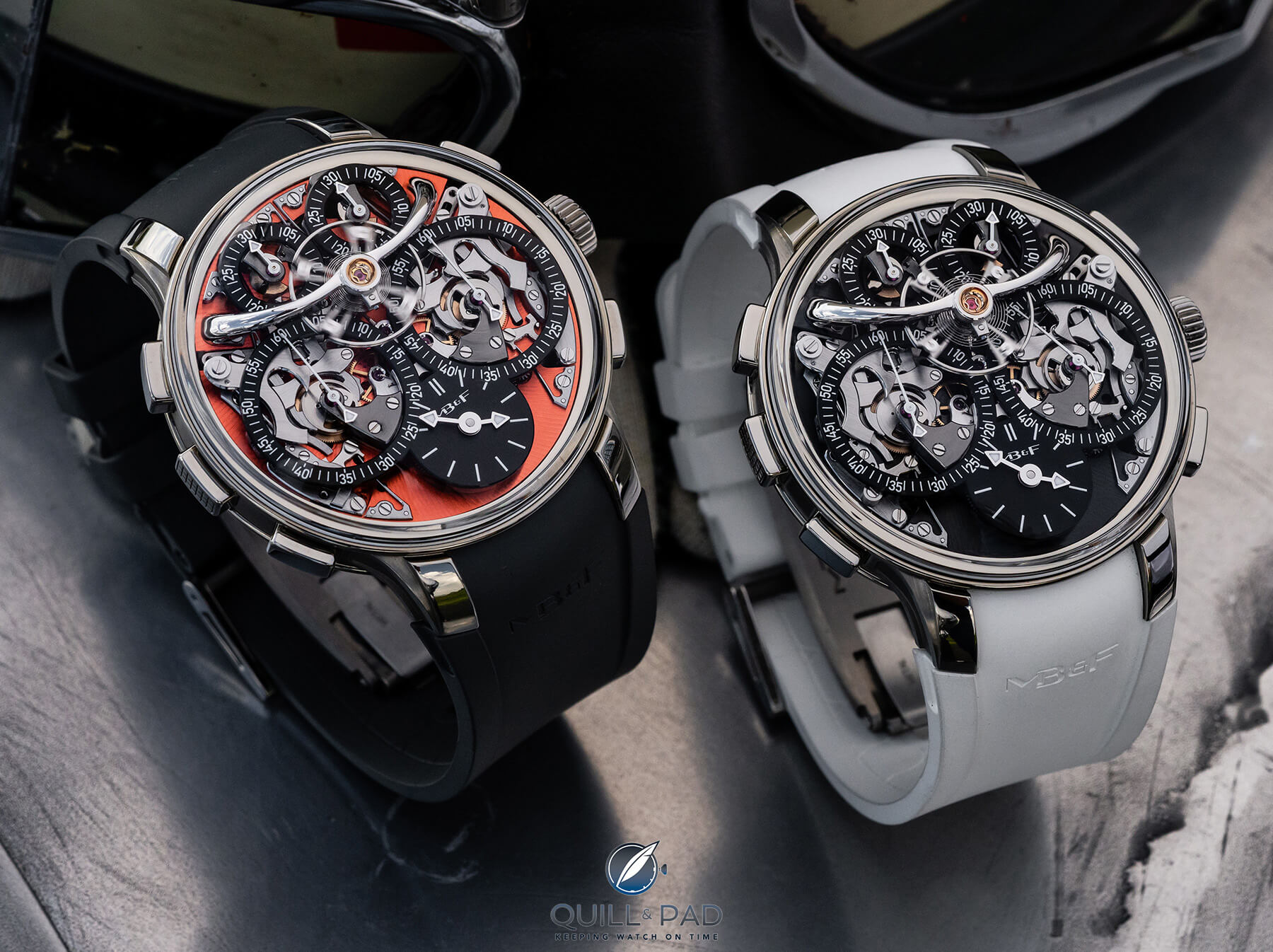
MB&F LM Sequential EVOs with orange and black dials
MB&F LM Sequential EVO: variations (in 2022)
LM Sequential EVO is available in two dial colors; CVD (not PVD) applied orange with black rubber strap and black with white rubber strap. Unsurprisingly, the bright orange dial stands out while the black dial is more subdued. The chronograph counters do stand out more with the orange dial.
Conclusion
Pros (and there are many): innovative use of a relatively simple idea; practical for somebody who uses a chronograph regularly as it offers a wide range of timing options; substantial size but easy wearing on wide range of wrists; ingenious and stunning engineering and mechanics (expanding the world of chronographs); good looks; and it’s a sports watch! A high complication that you can wear daily and on holiday.
When I first saw the MB&F LM Sequential EVO I thought it would hands down win the Chronograph category at the 2022 Grand Prix d’Horlogerie de Genève. And while it still might (and if so I’d think very deservedly), I now think that the Grönefeld 1941 Grönograaf will take that prize. Not because I think that the Grönefeld 1941 Grönograaf is a better chronograph (I think the two are so different as to be incomparable), but because the Grönograaf looks like a more traditional chronograph (but one with its own innovations) and I think that the GPHG jury leans toward the traditional – not that stopped the jury from awarding MB&F many prestigious prizes over the years.
It’s not so much that Sequential EVO is an unconventional chronograph, it’s that it’s likely to be polarizing. For some, the emphasis on highlighting the movement and mechanisms is something to be cherished, applauded, and appreciated all the time rather than occasionally in using the chronograph.
But for others, especially those considering using the chronograph functions regularly, having the clever mechanics on display under open subdials makes the chronograph indications (and there are four of them) more difficult to read than would be the case with a full dial.
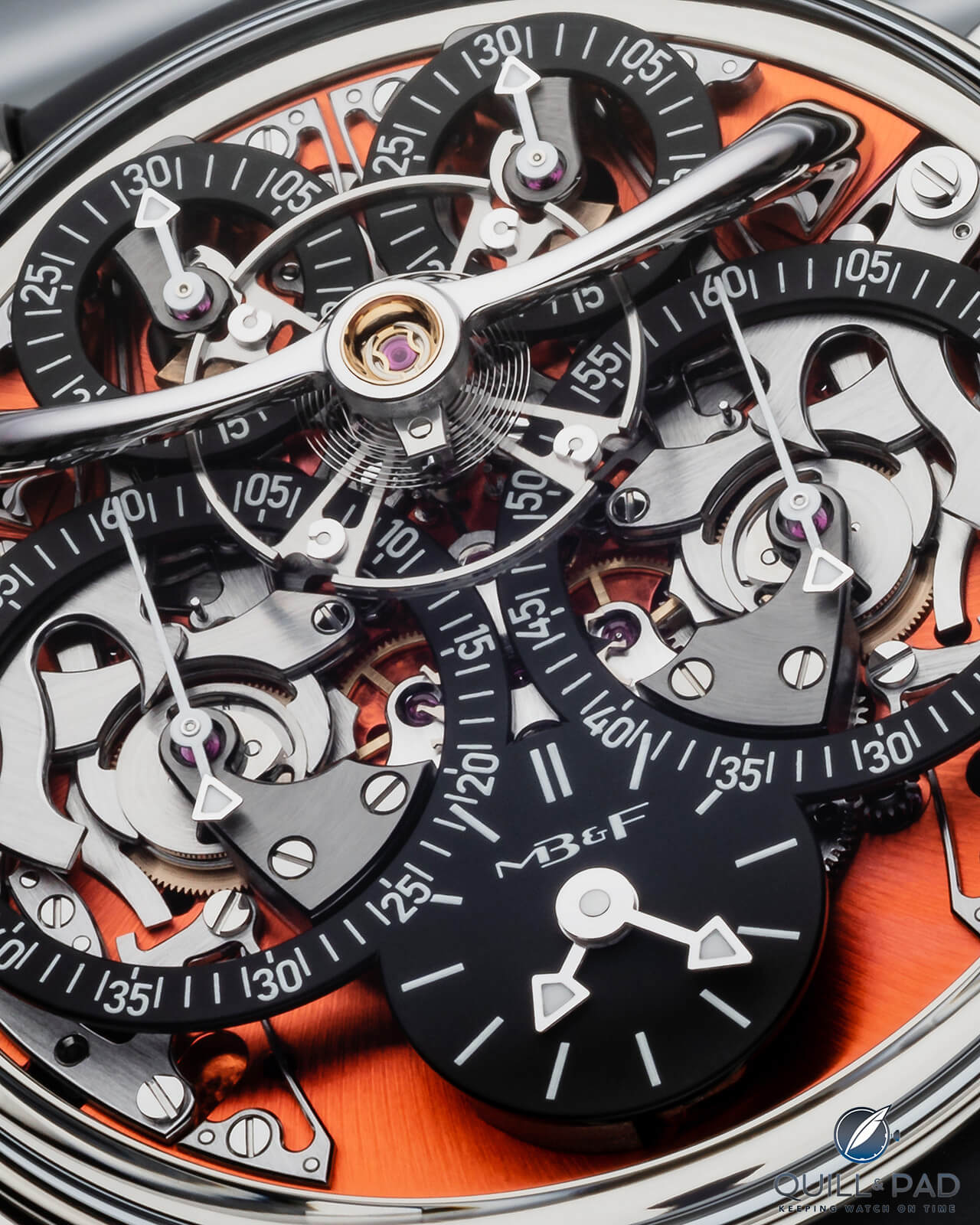
MB&F LM Sequential EVO dial closeup
The legibility of its chronograph counters is only a factor for those considering using the chronograph regularly, They may well be, and perhaps are likely to be, just a small percentage of those thinking to buy a Sequential EVO as everyone appreciates and uses watches differently. I can certainly appreciate the genius of the Sequential EVO without needing to time events daily. But I do think that the GPHG’s “Best Chronograph” should go to a watch optimized for use as a timing tool.
I should also note that the MB&F Legacy Machine Perpetual had busy open subdials showing mechanisms beneath and it won Best Calendar Watch at the 2016 GPHG (and was my choice), so what do I know?
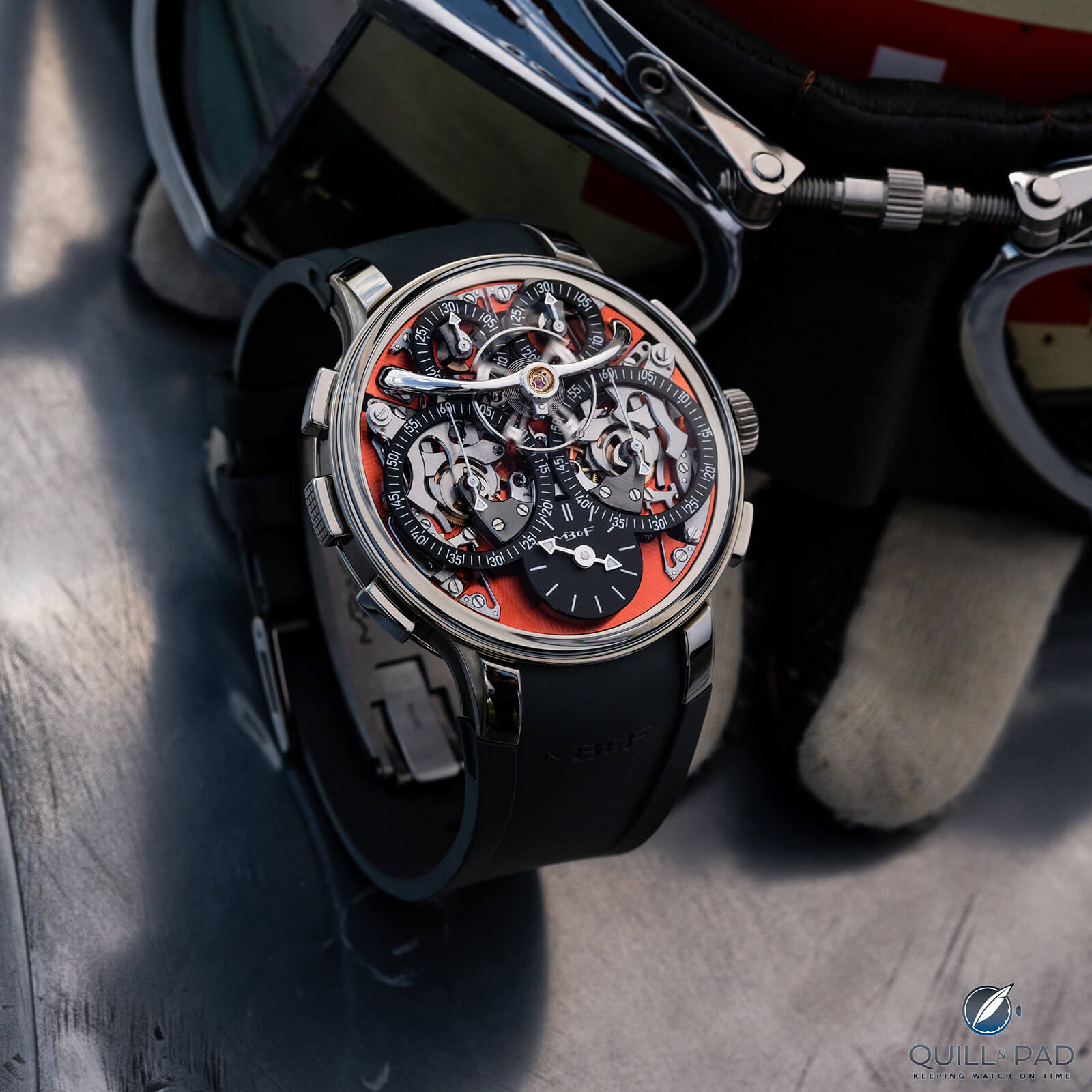
MB&F LM Sequential EVO with orange dial
I’m not somebody who uses or even owns a chronograph and I enjoy seeing into the mechanics, so I love the LM Sequential EVO for what it is. LM Sequential EVO is an innovative, clever, good-looking, useful, and very wearable (double) chronograph with a twist. I tip my hat.
For more information, please visit www.mbandf.com/en/machines/legacy-machines/lmsequential-evo.
Quick Facts MB&F LM Sequential EVO
Case: 44 x 18.2 mm, zirconium
Movement: hand-wound caliber developed by Stephen McDonnell with Twinverter switch, 3 Hz/21,600 vph frequency, 72-hour power reserve, double mainspring, flying balance wheel, 585 components
Functions: hours, minutes, seconds; dual chronographs
Price: CHF 160,000 / €160,000 / $180,000 excluding applicable taxes
You may also enjoy:
Why Legacy Machine Perpetual Catapults MB&F Into The Big League
Why I Bought It: MB&F Legacy Machine 101 2021 Edition
MB&F Legacy Machines: 10th Anniversary Retrospective And LMX
Leave a Reply
Want to join the discussion?Feel free to contribute!



Eeerrrrmmm. it is a hundred and sixty THOUSAND POUNDS and looks unfinished.
I genuinely hope the lessons learned from this project will be put to use in models which have a point m
What a great idear. Need it urgent. Where can I buy one near Zurich ?